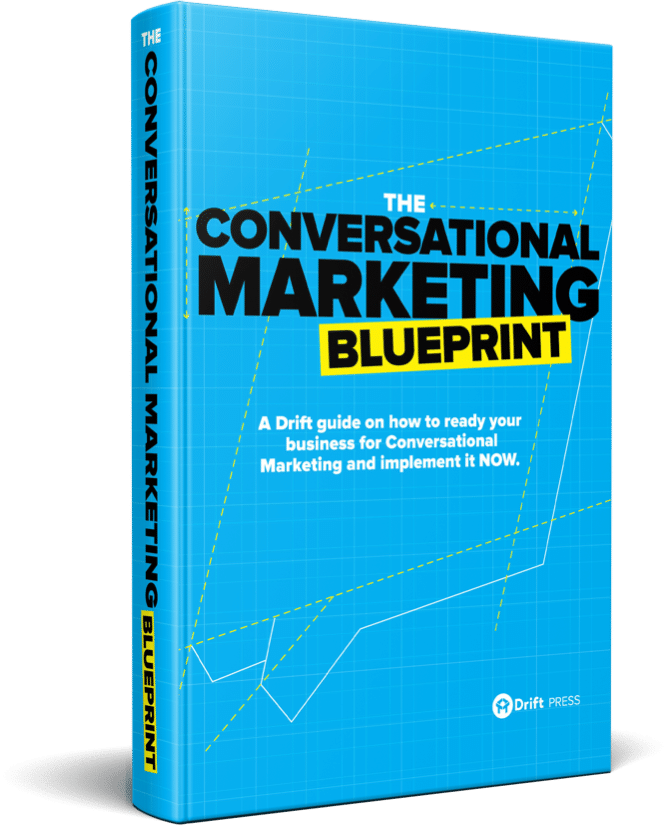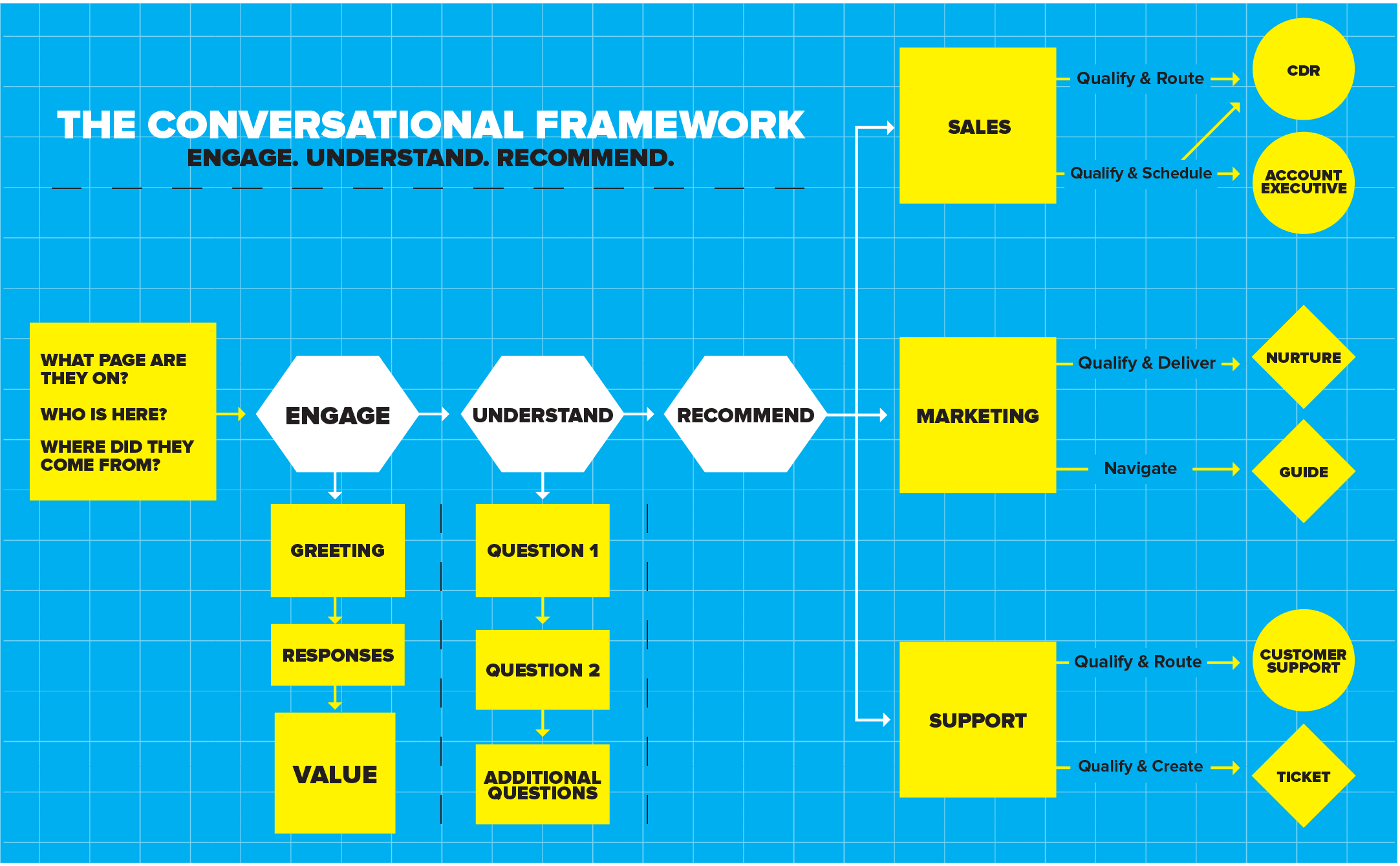Drift’s Conversational Marketing Blueprint: New B2B Playbook
Today’s customers have changed. With information and offers everywhere across the internet, no one has to wait to hear back from your business. If a customer has a question, the answer should be supplied right away—if you don’t, your competition most certainly will.
Drift, a leading conversational marketing platform, wants to transform the way businesses buy from other businesses through conversational marketing, a technique which consists of actively interacting with customers to create a more human-centric buying experience.
Instead of forcing web visitors to fill out static forms and wait days for a response, Drift uses intelligent chatbots and targeted messaging to engage with leads in real time.
The technique, also known as automated conversation marketing, helps convert leads faster, making it easier for people to connect with your company via their preferred channel.

From data-driven to customer-driven
Drift wants to remind companies leads are more than just faceless entities that exist solely inside spreadsheets.
To help educate the future of sales and marketing on this new wave, Drift has recently published The Conversational Marketing Blueprint, a book that breaks down the rise of a conversation-centered approach and outlines the strategies that successful businesses use to generate leads.

The blueprint is authored by VP of Marketing, Dave Gerhardt, and David Cancel, Drift founder, CEO and contributor who declares of the guide:
“The traditional B2B playbook was all about making customers wait for later. But today, the balance of power has shifted and customers—not companies—control the buying process. This is the playbook for the future of sales and marketing [...]”
A new framework
Drift’s conversational marketing proposes a new framework in favor of a customer-centric approach, as opposed to the old, business-centric model. Conversational marketing always puts the customer first.
The old approach offers a generic experience that lacks personalization. By adopting a new, conversation-focused strategy, companies can treat customers like unique individuals, let them buy on their terms and timeline, and provide a service tailored to their needs.
In today’s digital landscape, businesses must act increasingly fast to obtain potential customers’ attention. As new communication channels emerge, each one you use to get in touch with your audience is getting more and more crowded, reducing your opportunities to drive more traffic to your sales funnel.
Conversational marketing is more than a new channel or funnel. It is like a top layer for your entire company’s strategy that helps customers get what they want immediately, no matter the channel.
The Conversational Marketing Blueprint exists to help you map the conversations customers want to have with your business. It defines the “who?” “where,” “what,” “when,” and “why ”of your buyer’s journey, and shows you how to answer those critical questions to build your conversational marketing strategy.
The Five Ws

With conversational marketing, you can engage with customers based on who they are, where they came from, what page they are viewing, and for which specific reason.
What
Identifying what web page a potential customer is viewing is one of the simplest ways to personalize your conversational marketing. Simply engage the visitor in a conversation based on the page they are currently visiting.
People will most likely identify themselves as leads on high intent pages, which include sections like “Contact Us,” “Pricing,” or “Request a Demo.”
Potential customers will also most probably view your homepage to get a general outlook of what your business does, educational pages that provide specific information about your products, and informational pages which usually consists of “About Us,” “Our Mission,” “Careers,” and “Press” sections.
Who
The next step consists of recognizing who your website visitors are so you can personalize the conversational engagement and deliver more relevant messaging.
As the majority of your traffic is likely anonymous, Drift uses cookies to understand how each visitor engages with your pages and what their intents are. You will know if someone returns to your site even if you have not converted them into an account yet. Drift will also let you know if existing leads from a capture form, newsletter signup, or a live chat conversation are continuing to view your site.
Where
Mapping out the specific channels of where visitors come from to get to your site will also help you create more personalized conversations.
The most common visitors to your website are people who have heard about your brand before. They type in your URL to learn more about your products and offers. You also get visitors through ad campaigns. The context of those ads and the pages they direct to will ultimately help you understand what interest or intent visitors have.
Nurture campaigns provide additional context to give you a sense of what drove a person back to your site. You will know precisely who the visitor is as well as what interested them in engaging with your nurture email.
Traffic also varies based on your SEO strategies. You can use specific keywords to infer what people may be searching for and increase the number of relevant visitors. You can also generate traffic by creating CTA prompts.
Using third-party content to drive awareness about your brand gives you the opportunity to engage in personalized conversations based on the precise content that drove a visitor to your site. For example, if a blog posts a review of your business and it starts generating traffic, you can greet visitors coming from that content with a message thanking them for reading the article and asking them which part caught their attention. In this manner, you can immediately identify their interests before moving onto a recommendation.
Why
Once you have engaged a visitor and know their intent, you should recommend the next steps for that person by asking why they are viewing your site.
For example, a buyer who has engaged in a chat may be seeking an answer to a specific question. You can, therefore, direct the conversation to a development representative who will provide a solution and secure the next steps to help that person.
A visitor who is interested in learning more about using a product can book a meeting or meet with an account executive right away if they need further explanation.
When
As Cancel and Gerhardt put it, “the right time to engage with a buyer is always now.”
You must take action and engage a conversation with potential customers as soon as they are showing intent or interest.
Building a chatbot to qualify leads

After having conceptualized the buying experience from the customer point of view, you want to promptly drive qualified leads into a conversation with the right team members.
Cancel and Gerhardt’s advice is to create a chatbot that will engage with visitors, understand what they want, and recommend them the next steps to take.
Unlike lead capture forms, a bot can automatically send targeted and personalized messages to engage with the highest valued leads. Think of it as having an intelligent sales assistant initiating conversations with potential customers 24/7.
Engage
To start a conversation with visitors, you must first take into account where they are, not only on your website but within their buying cycle. Asking a question about a pain point your products help solve will open up the conversation. For example, the Drift homepage bot asks, “Are you currently driving qualified conversations on your website?”
This type of question gives you the opportunity to explain how your business will help potential customers, why they should choose you, and why similar companies are already buying from you.
You can start conversations by acknowledging how your visitors came to your site, whether they represent returning traffic or newcomers. For registered accounts, acknowledging them by name or company name will make the experience even more personalized.
For example, Drift’s Google Adwords campaign Bot starts with “Thanks for coming all the way over here from Google. What caught your eye about our ad?”
Another example: if someone has been visiting your site two or three times, you can a send message saying “Welcome Back!”
Understand
Getting a better understanding of your visitors’ identity and needs will allow you to recommend the right next steps. You can start using more specific questions that will give you a good sense of how a potential customer would use your product.
For example, Drift’s bot asks what potential customers want to use Drift for, and their company size.
Recommend
You can then create default follow-up options based on answers. For example, if a visitor replies that they want to use Drift for sales, they will receive the default answer, “Nice, over 20,000 sites are using Drift to grow sales.” They will automatically become qualified as a lead, and the conversation is routed to the sales team.
Impact
Cancel and Gerhardt conclude their Blueprint guide by reminding us that even though you need to observe several metrics to measure the impact of your conversational marketing, you must focus on the numbers you are trying to move. That could translate to the traffic driven towards a specific page, or the number of meetings booked.
The future of B2B marketing
In a market that is notorious for its lack of personalization, Drift creates valuable, human-centric, and customer-focused strategies that businesses can easily apply to maximize lead conversion and growth.
Besides helping readers understand the principles and benefits of a conversation-focused approach, Conversational Marketing Blueprint offers simple, concrete explanations that facilitate its implementation in any business.
By providing a right balance between theoretical elements and practical application, this guide makes conversational marketing accessible to all organizations, paving the way for the next wave of B2B sales.




